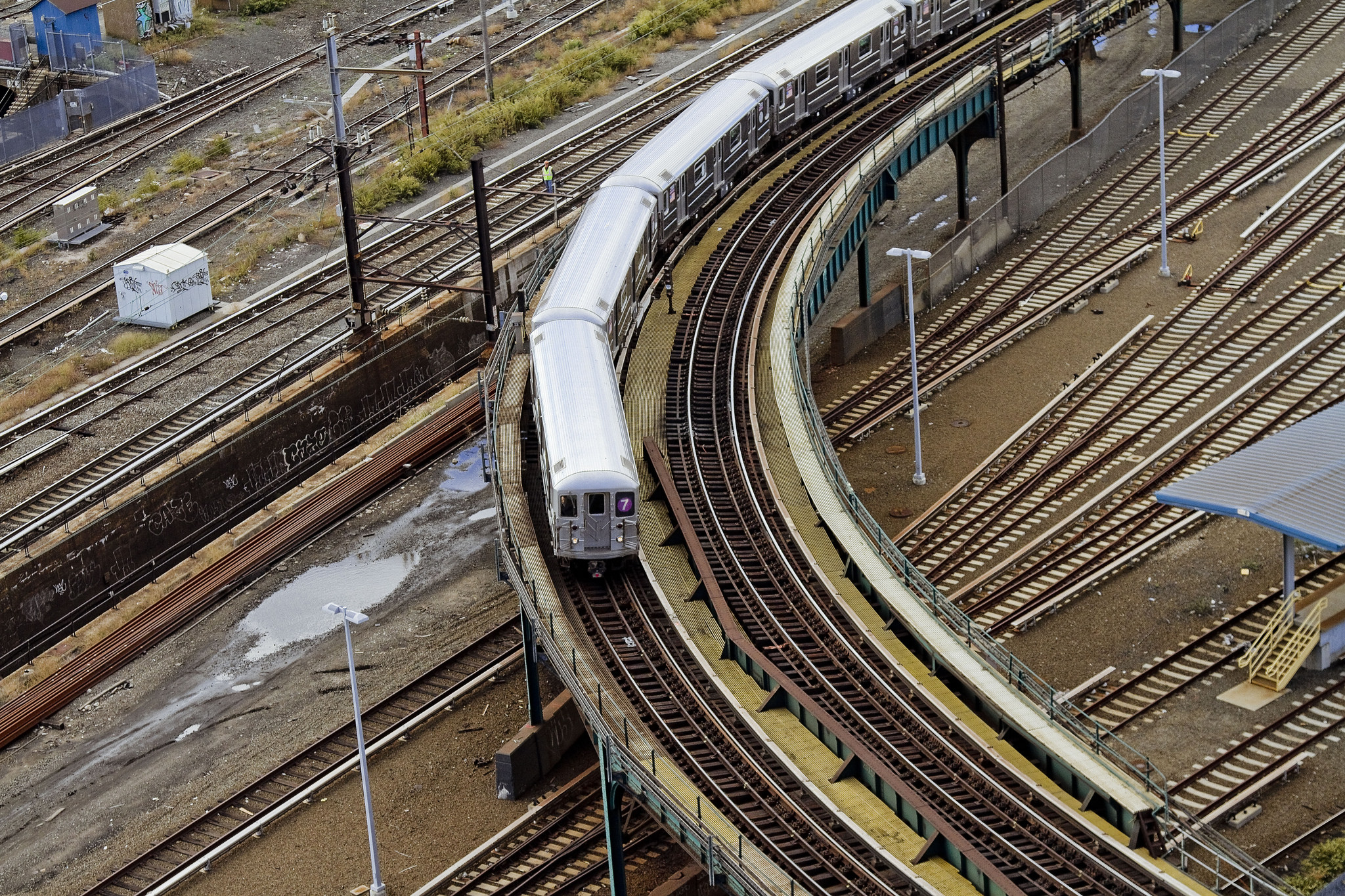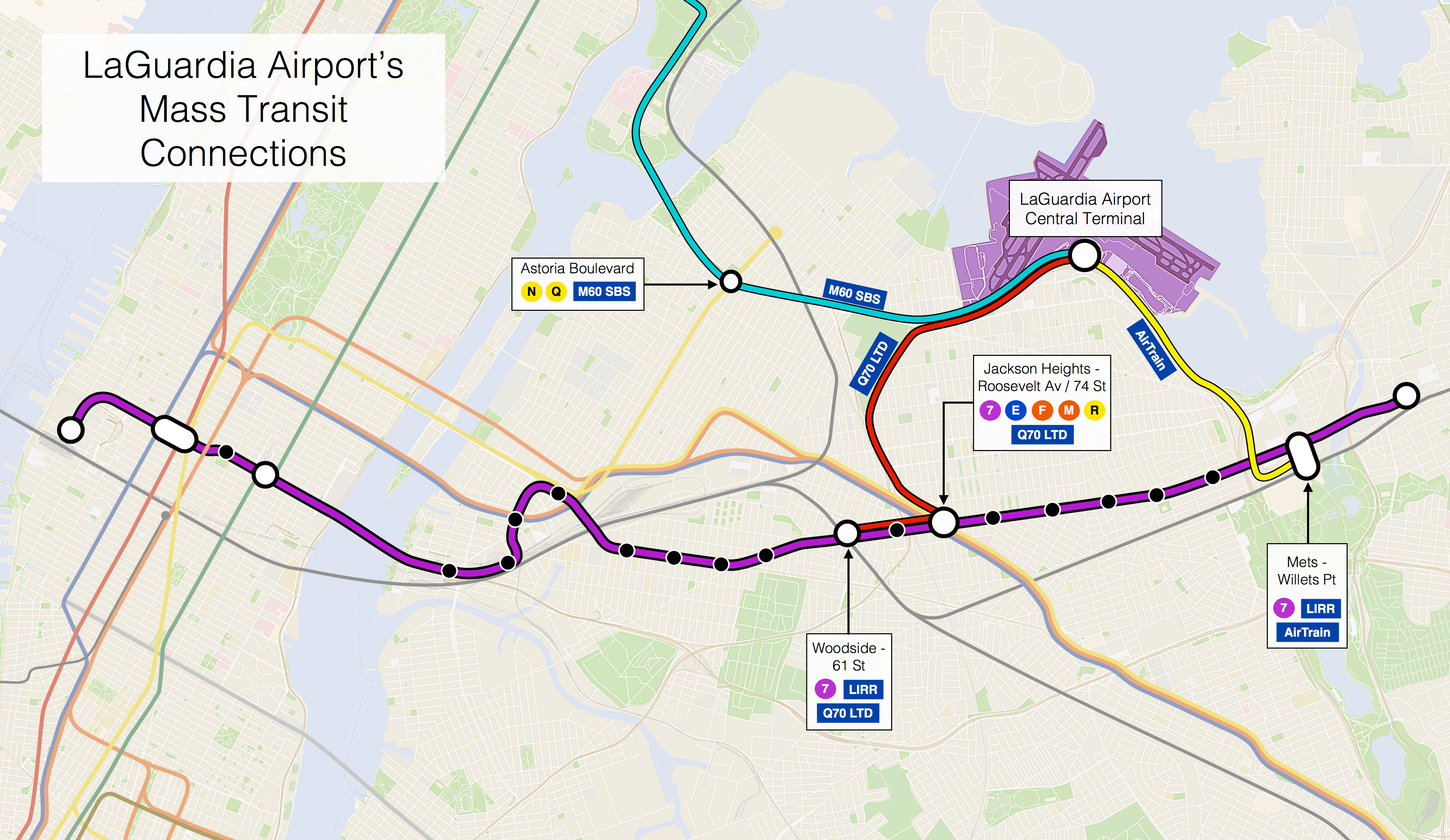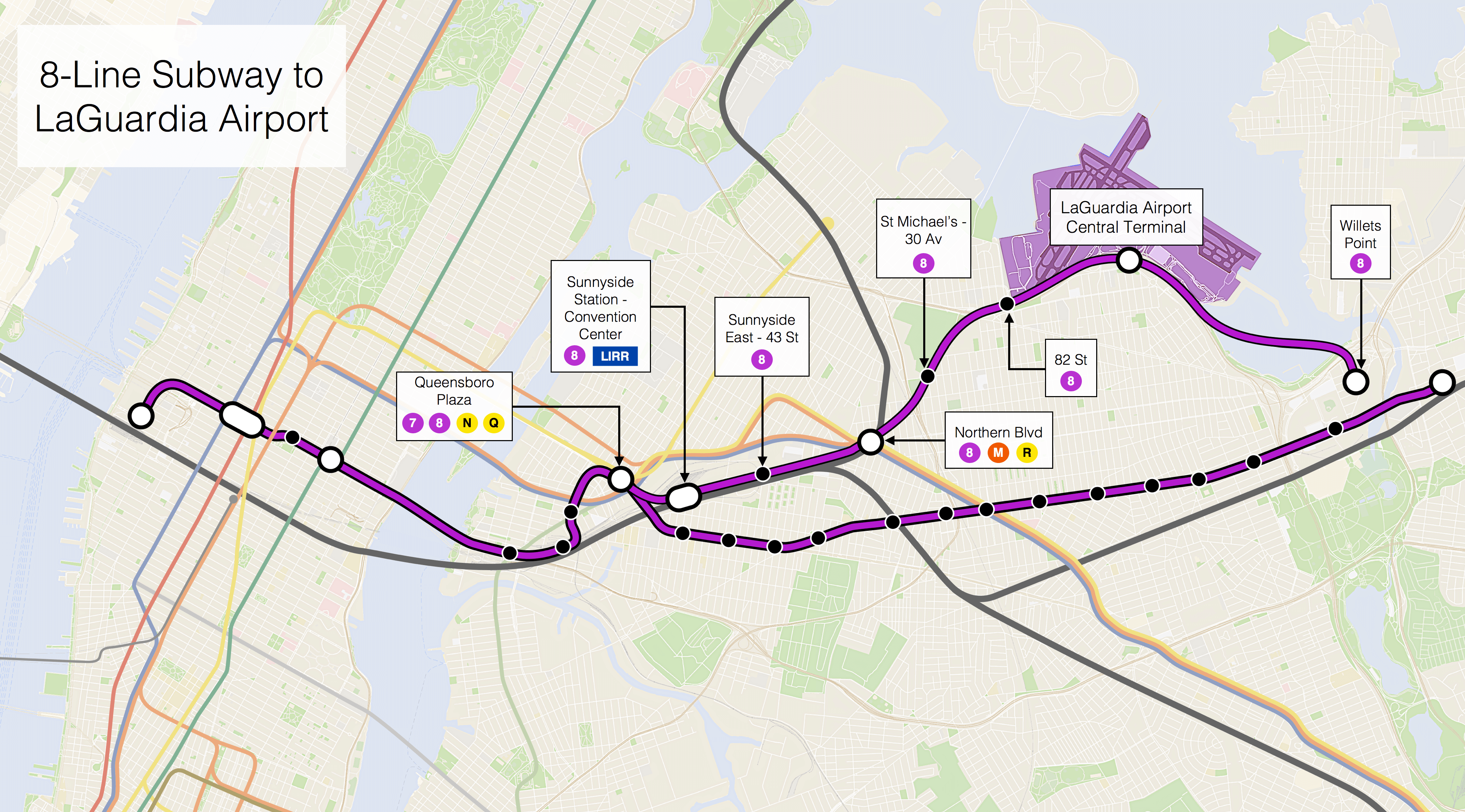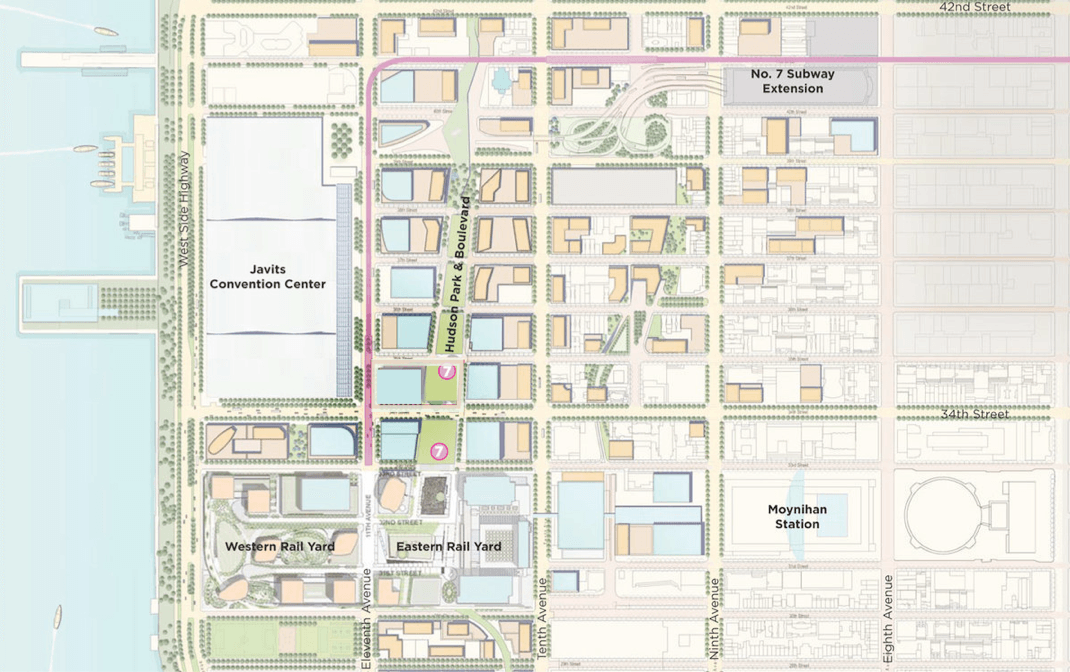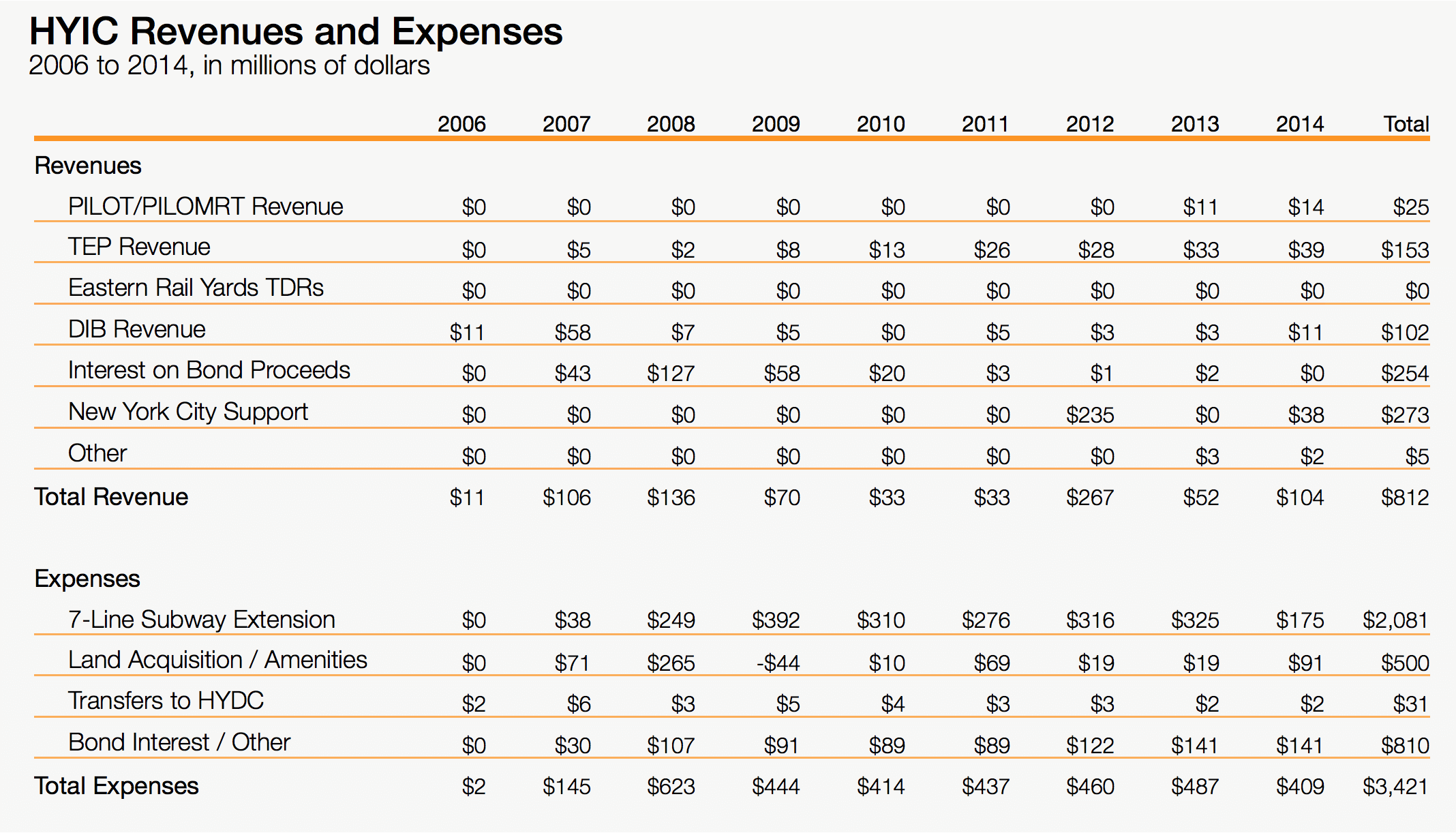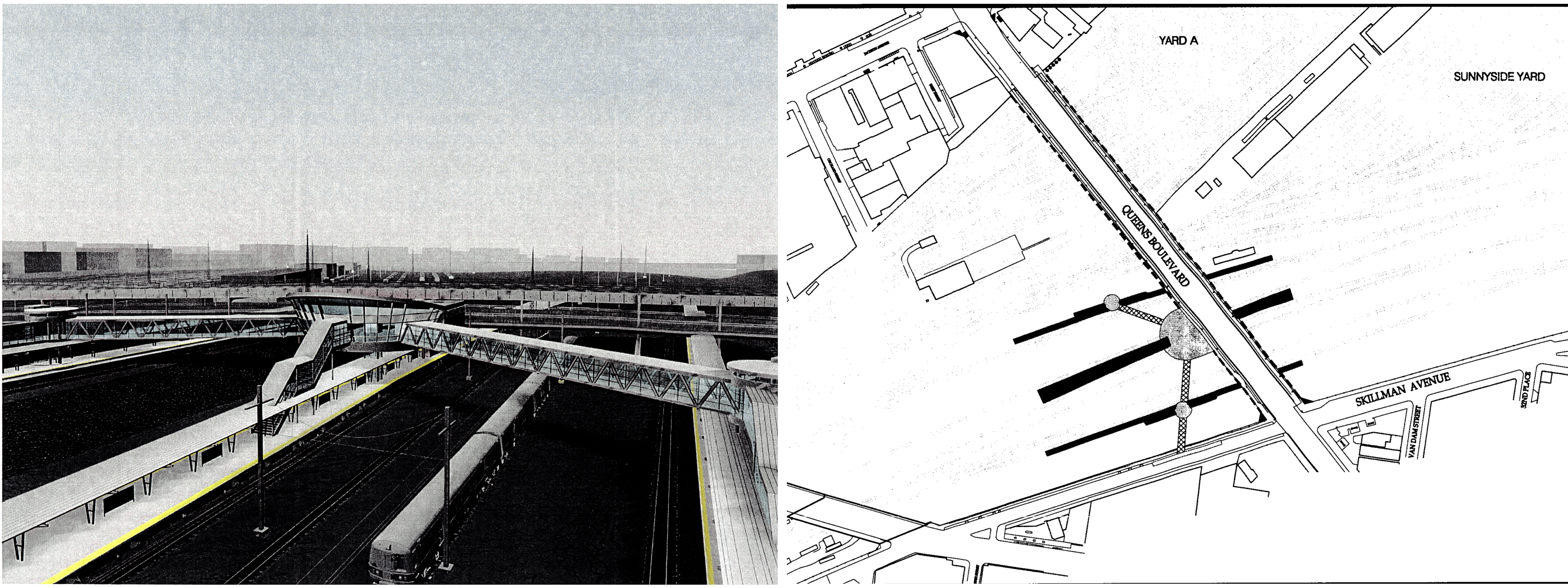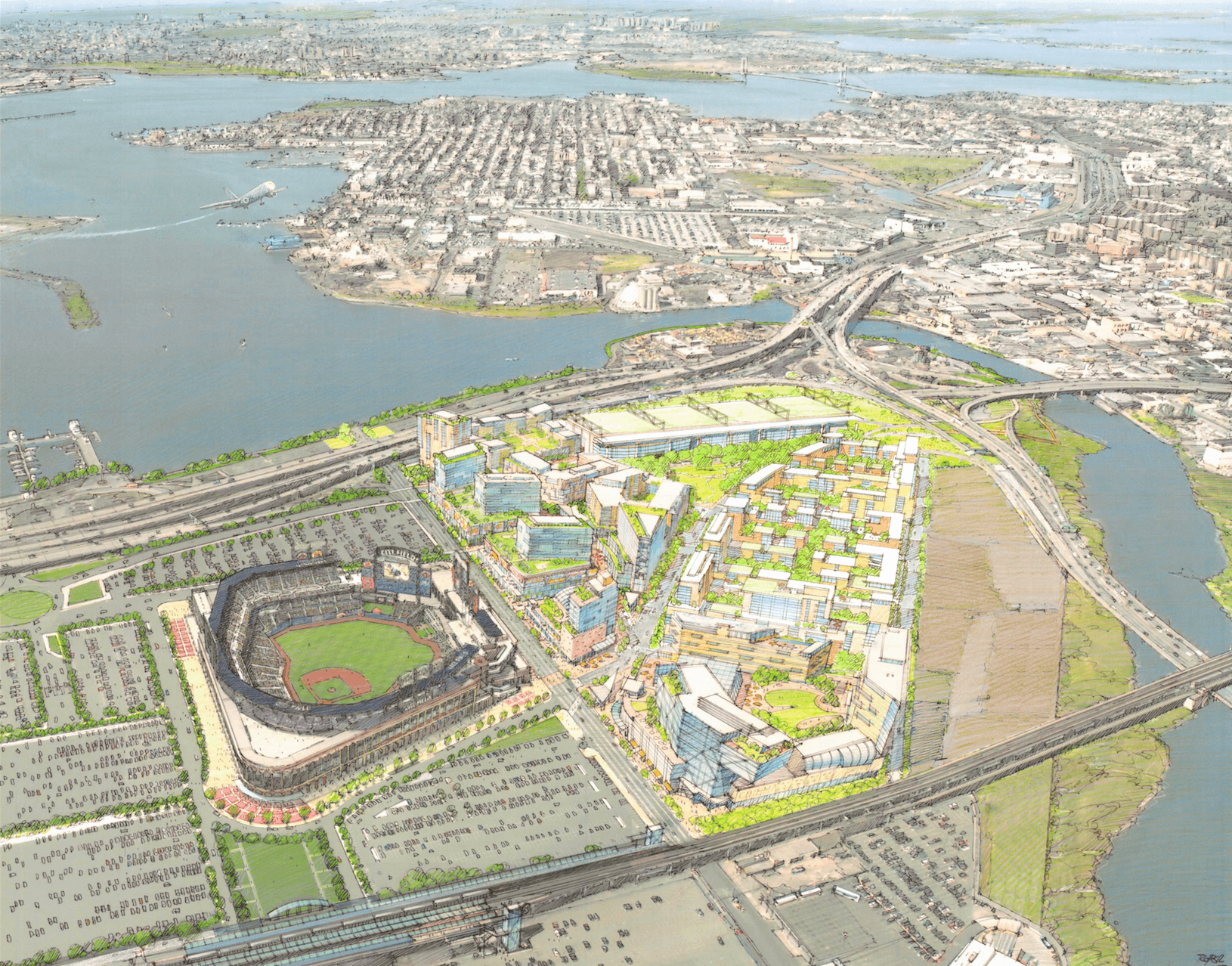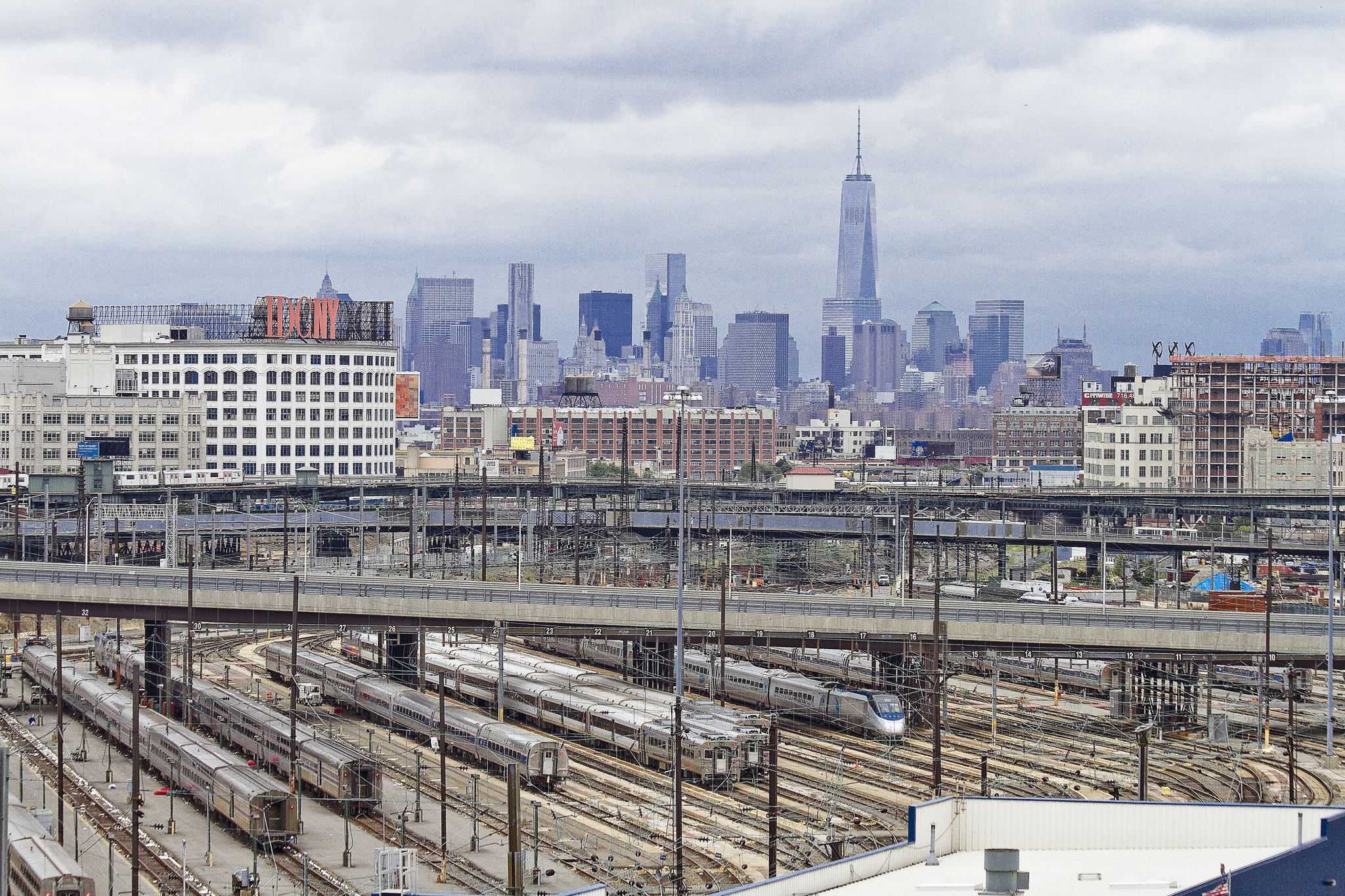Connecting the Dots in Queens: A Smarter Path to LaGuardia Airport
Throughout his tenure as New York Governor, Andrew Cuomo’s expertise as an urban planner has, at times, struggled to reveal itself. For instance, in 2012, Governor Cuomo announced a massive development plan to raze the Javits Center and construct a new 3.8 million square foot convention center complex at the Aqueduct Raceway. Critics denounced the plan not only because of the relative isolation of the Aqueduct Raceway site within New York City, but also because the Javits Center was still in the midst of a $465 million renovation and expansion. Nevertheless, just several months after his initial announcement, Governor Cuomo scrapped his plan to build the nation’s largest convention center after talks with the project’s chief financier and casino giant, Genting Group, broke down.
In the realm of mass transit, Governor Cuomo launched the MTA Reinvention Commission to “develop a reinvention plan to make our subways and our entire transit system ready for the challenges of the next century.” However, upon the release of the commission’s final report, critics were let down by the lack of actual “reinvention” in its suggestions. Writing for StreetsBlog NYC, Stephen Miller asserted that under Governor Cuomo’s leadership, the MTA Reinvention Commission’s report “fail[ed] to seriously grapple with the biggest challenges facing New York’s transit system,” and the “MTA’s astronomical construction costs and the substantial systemwide benefits of funding transit with road pricing [received] only cursory mentions.”
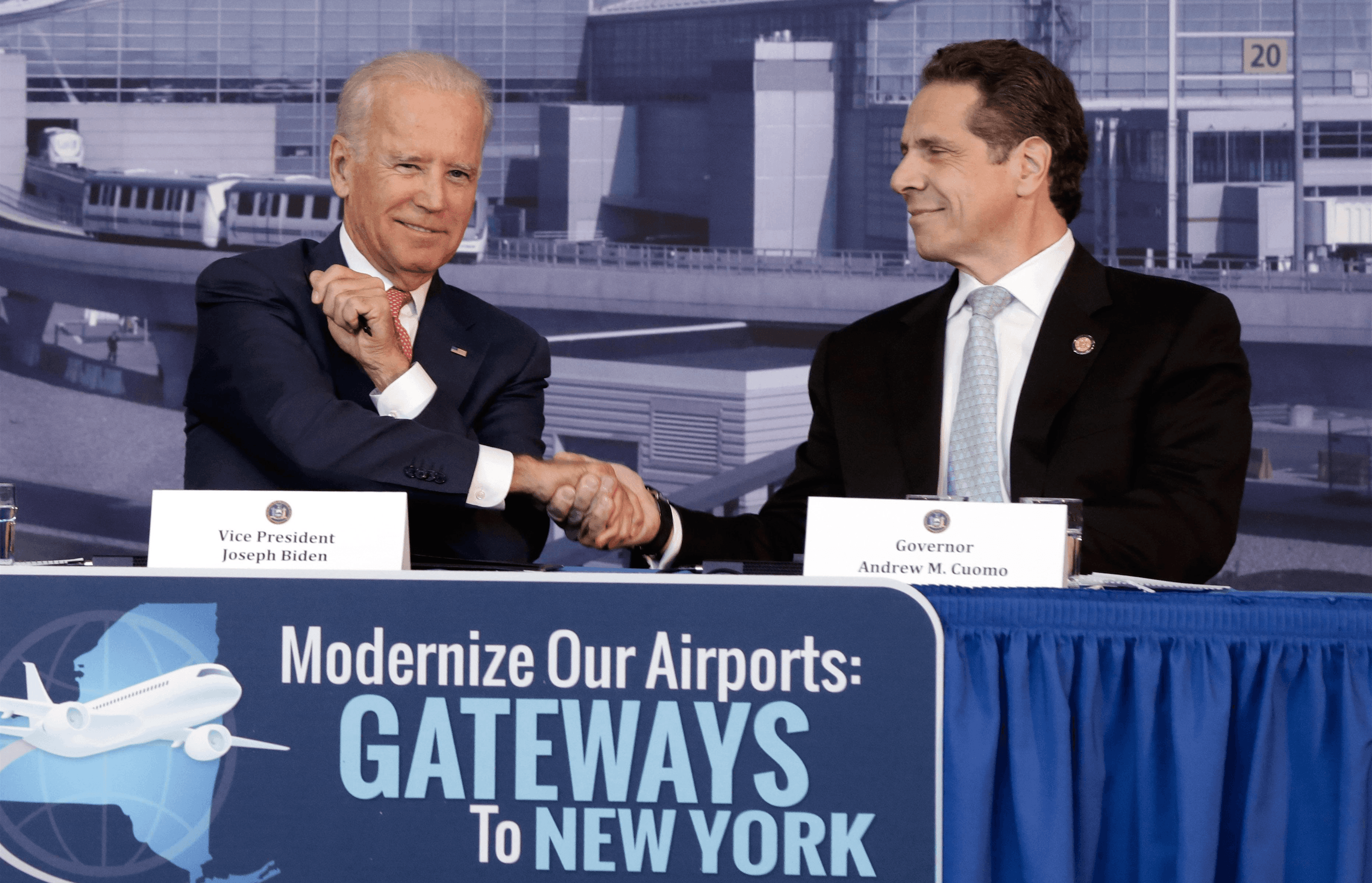
Then Vice President Biden and Governor Cuomo Announce a Design Competition to Overhaul New York’s Airports
When Governor Cuomo announced a public competition to overhaul and redesign New York’s failing airports, including LaGuardia, transit advocates were excited by the opportunity to reinvision the metropolitan region’ transportantion infrastructure. President Biden, who once compared LaGuardia Airport to “some third-world country,” appeared at the announcement’s press conference. The master plan design competition was meant to “call on designers from across the globe to strategically envision the complete package of what LaGuardia Airport will look like and how it will function in the 21st Century.” Entrants were tasked with enhancing the overall customer experience at LaGuardia with a focus on “improving transportation to the airport.” As Governor Cuomo would later describe the design competition, “we asked the designers to be creative. The sky’s the limit, start with a blank piece of a paper and just give us a vision for the most competitive airport on the planet.”
In spite of the seemingly limitless opportunity for change, just a week before the competition’s January 30, 2015 submission deadline was reached, Governor Cuomo announced the curtailment of that “blank piece of paper” by imposing his own mass transit plan for LaGuardia Airport. He announced that New York State would construct a new AirTrain connecting the airport to the 7-Line subway and Long Island Rail Road (“LIRR”) stations at Willets Point at a cost of $450 million. Speaking at the 2015 Opportunity Agenda on January 20, 2015, Governor Cuomo explained his proposal:
You can’t get to LaGuardia by train today, and that really is inexcusable, and that we’re going to change over the next several years. ... We will construct an AirTrain that will connect with the Route 7 subway line and the Long Island Rail Road at Willets Point. That is about a mile and a half [of] construction. It will run along the Grand Central Parkway in an area that we believe won’t create an undue burden to any of the neighboring structures and connect a one-ride from the subway system or the Long Island Rail Road to LaGuardia, which is truly long overdue.
It appeared that Governor Cuomo’s vision for a new beginning at LaGuardia Airport would be—to the behest of transit advocates, city planners, residents, and visitors alike—tempered in scope and impact. The governor had thrown a previously unannounced wrench into the equation, and for Manhattan-bound travelers, the new AirTrain would actually usher them farther into Queens. Predictably, the criticisms that followed Governor Cuomo’s latest announcement have been both swift and diverse.
Criticisms of Governor Cuomo’s AirTrain Proposal
Transit blogger Benjamin Kabak of Second Avenue Sagas described Governor Cuomo’s “out of nowhere” plan as “something of a bombshell” and expressed “serious reservations” about the way the AirTrain plan came about:
It’s a connection, but it’s not a direct one. It doesn’t help improve access to Laguardia for airport workers, and it shifts economic resources from other projects and proposals that should be a priority.
Mr. Kabak argued that the AirTrain’s greatest shortcoming is its failure to identify a real funding source for its $450 million price-tag, especially in light of the MTA’s $15 billion budget gap for its own five-year capital plan. However, as MTA head Tom Prendergast explained at a January 29, 2015 budget hearing, the “range of costs is actually probably from half a billion to $1 billion.” In sum, Mr. Kabak noted that “[i]t made little sense at $450 million; it makes no sense at $1 billion.”
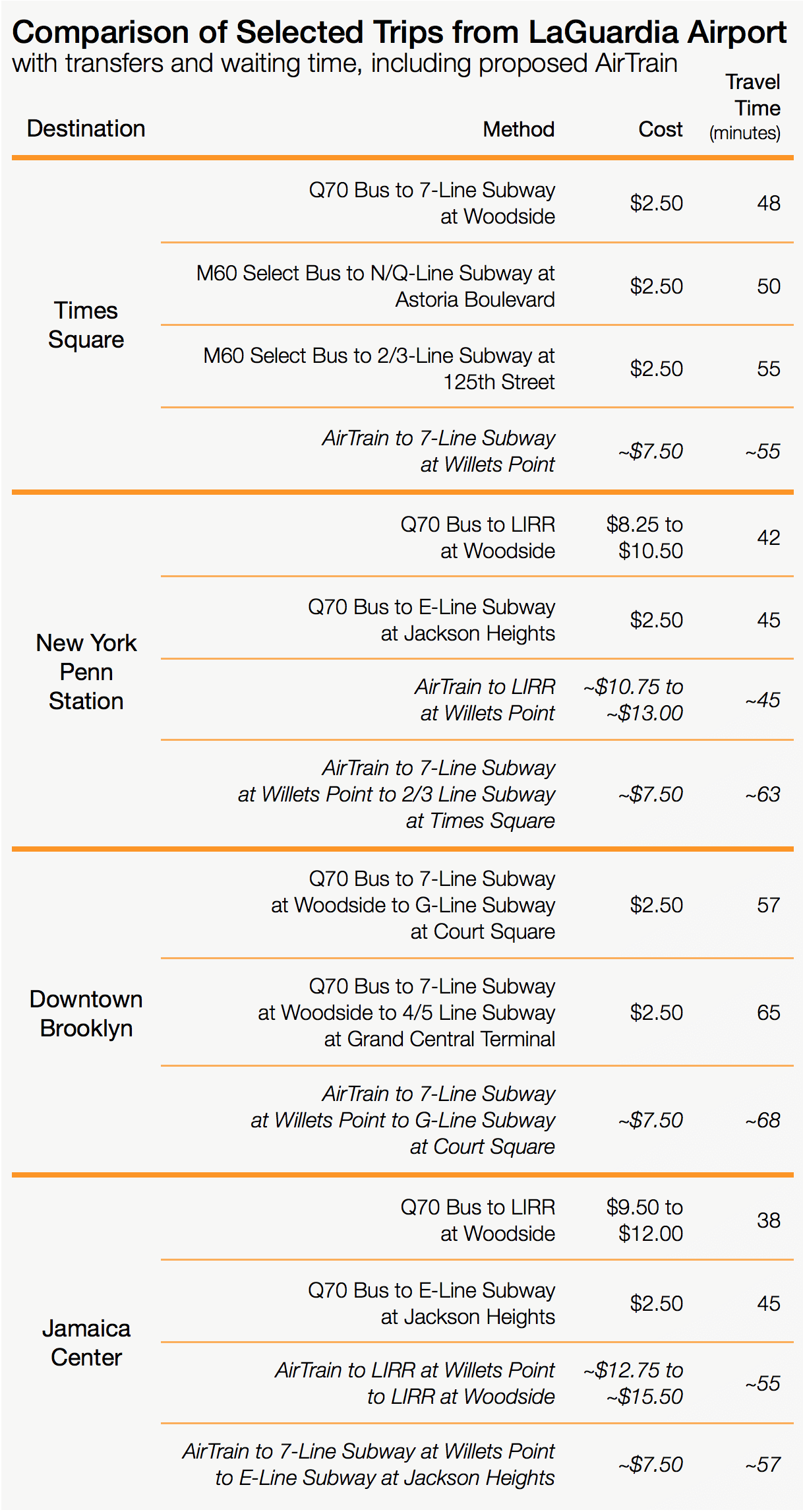
Yonah Freemark of The Transport Politic focused his criticisms on the AirTrain’s route alignment, which he found would “save almost no one any time.” Indeed, under Governor Cuomo’s AirTrain proposal, which would be served by the Mets-Willets Point station near the very end of the 7-Line subway, it would still take about an hour to travel to Times Square from LaGuardia Airport with transfers and waiting time. In addition, the Mets-Willets Point LIRR station is only reachable from the Port Washington Branch, which today runs only two hourly trains in each direction and accounts for only 16% of LIRR’s daily ridership. By comparison, both the Q70 Limited Bus and M60 Select Bus, which began express service to LaGuardia Airport in 2013 and 2014 respectively, are directly accessible from 17 different subway lines and offer trip times to midtown Manhattan closer to the 45 to 50-minute range with transfers and waiting time.
Even if Governor Cuomo’s AirTrain was able to shear a few minutes off of current alternatives to LaGuardia Airport, it is unclear just how many people would take advantage of an AirTrain to Willets Point over a taxi or even existing mass transit options, especially considering the relative differences in cost and convenience of choice. Assuming comparable pricing to the AirTrains at Newark-Liberty and JFK Airports, Governor Cuomo’s AirTrain option would likely cost $7.50 per ride coming from the 7-Line subway, whereas the current Q70 Limited Bus and M60 Select Bus cost just $2.50 per ride with a free transfer from any of the 17 connecting subway lines. In his recent article discussing Governor Cuomo’s AirTrain proposal, FiveThirtyEight’s Nate Silver explained why a cab will likely continue to be the primary choice for travelers from LaGuardia Airport under the majority of circumstances:
The problem is that the proposed AirTrain would initially route Brooklyn- and Manhattan-bound travelers in the wrong direction — farther into Queens — requiring them to double back to reach their destinations and reducing any potential time savings. ... This is part of why the routing of the proposed AirTrain matters so much. If it winds up shaving only five minutes off travel times to Manhattan — and some analysts are skeptical it will save any time at all — it will be a good backup plan for budget-conscious travelers or when the taxi queue runs to Citi Field, but a car will usually be faster. If the AirTrain knocks 15 minutes off instead, it will be an option worth considering under a much broader range of circumstances.
A Smarter Path to LaGuardia Airport and a Greater Opportunity for Queens
The better way to tackle the LaGuardia Airport transit problem is to incorporate a rail connection into the broader expansion of mass transit in Queens, which would allow for significantly reduced trip times and greater overall access to transit. Specifically, the MTA should extend a new elevated branch of the 7-Line from Queensboro Plaza through Sunnyside Yard to LaGuardia Airport before terminating within the new Willets Point Development District. Unlike Governor Cuomo’s AirTrain proposal, this new “8-Line” subway would offer travelers a true one-seat ride in between LaGuardia Airport and midtown Manhattan in about 25 minutes, which would be cab-competitive even during off-peak hours. A Sunnyside Yard alignment would also allow for the construction of infill stations in subway-lacking pockets of northern Jackson Heights and East Elmhurst. Finally, locating a new subway station at Sunnyside Yard would allow for a connection to a new Sunnyside Yard LIRR Station, which, unlike the Mets-Willets Point LIRR station, would be directly accessible from every Manhattan-bound LIRR train in the system and eventually Metro North New Haven Line trains as well.
A Sunnyside Yard branch of the 7-Line would obviously be more expensive than a two-station AirTrain to Willets Point. But unlike Governor Cuomo’s proposal, a more comprehensive transit expansion to LaGuardia Airport through Queens would create significantly greater opportunities to capture the long-term economic value created by the subway line’s construction. As a result, a Sunnyside Yard alignment would actually be more affordable in the long run than Governor Cuomo’s AirTrain proposal, which currently fails to identify any concrete or lasting source of funding.
Perhaps one of the most successful uses of value-capture mechanisms to make transit projects more affordable may be seen at the Hudson Yards, where for the last decade the MTA has been constructing the 7-Line subway extension to 34th Street and 11th Avenue without any dedicated funding from the MTA itself. Instead, the Hudson Yards Infrastructure Corporation (“HYIC”), which was created by New York City to finance the project, was able to raise $3 billion in proceeds from two bond issuances that were secured with future revenues to be generated by real estate developments built in the vicinity of the new subway station. The HYIC has been able to raise money from these future transit-oriented developments using a number of common value-capture methods.
The HYIC’s largest source of revenue is set to come from commercial payments in lieu of property taxes (“PILOTs”). In order to incentivize new developments prior to the build-out of the Hudson Yards site, the City discounted these PILOT rates below normal property tax rates depending on the location and completion date of a new development. For those developers choosing to opt out of the PILOT program, the City has agreed to repay the HYIC all property taxes received from buildings constructed in the project zone after 2005 in the form of Tax Equivalency Payments (“TEPs”). Another source of revenue for the HYIC will come from the sale of various transferrable development rights (“TDRs”) tied to the development of the eastern half of the MTA’s West Side Yard (the “Eastern Rail Yard”). These TDRs allow Hudson Yards developers to increase a property’s zoned floor-area ratio (“FAR”), which in turn allows for the construction of taller buildings. Developers may also increase a site’s FAR through the purchase of District Improvement Bonuses (“DIBs”) from the HYIC, which function in a similar manner to the Eastern Rail Yard’s TDRs. Even though vertical construction within the Hudson Yards development site has just begun on only a small portion of buildings, and the full implementation of the Hudson Yards master plan is still decades away, the HYIC has still been able to generate over $500 million in value-capture revenue over the past seven years.
Capturing Value in Queens Through Transit-Oriented Development
Like the 7-line extension to the Hudson Yards, a new 8-Line elevated subway branch to LaGuardia Airport would catalyze the buildout of two key real estate development opportunities, which would in turn help secure financing for the overall project. The first opportunity piggybacks off of Governor Cuomo’s failed Javits Center proposal. However, instead of locating a new convention center far from Manhattan at the Aqueduct Raceway, a new convention center complex would be constructed over the massive Sunnyside Yard, which is conveniently located at the Queens entrances to the Queensboro Bridge and Midtown Tunnel. Covering nearly 200 acres of land, the Sunnyside Yard development site provides ample space for the construction of the nation’s largest convention center with plenty of room to spare for complimentary hotel, retail, commercial, residential, and open park development. At street level alone, the Sunnyside Yard site encompasses approximately 7.5 million square feet of space. And unlike the Aqueduct Raceway site, the Sunnyside Yard site is easily accessible to numerous existing subway and LIRR lines.
The construction of a dedicated Sunnyside Yard subway/LIRR/Metro-North station at the entrance to the project site would make a new convention center built there among the most transit-friendly, market-competitive, and modern event spaces in the nation. Amtrak, who owns the underlying property and is suffering from their own long-term capital budget problems, has signaled their willingness to work with the City and private developers to build out the Sunnyside Yard. And the MTA’s East Side Access project already includes provisions for the construction of a LIRR infill station at Sunnyside Yard. Finally, after the completion of a new convention center in Queens, the State would be able to raze the Javits Center and sell the underlying land, which would, by that time, be surrounded by new developments at the Hudson Yards and command significantly higher premiums than today.
The second development opportunity is already underway at Willets Point, where the New York Economic Development Corporation (“NYEDC”) has been working to transform 62 acres of industrial land into approximately 9 million square feet of new commercial, retail, residential, and park space. The NYEDC estimates that the redevelopment of Willets Point, which is slated for completion by 2032, will result in $25 billion in economic production over the next 30 years. While Willets Point already has a 7-Line subway station, the bulk of the development site’s 6,000 new residential units would be located more than a half-mile from the station’s entrance across from Citi Field. Bringing a new 8-Line subway branch to the center of the Willets Point Development District would not only catalyze development there, but would also allow trains to conveniently terminate at the existing Corona Yard.
With sufficient coordination and long-term planning, the MTA would be able to construct a new 8-Line subway branch through Sunnyside Yard to LaGuardia Airport without having to dip into its already overburdened coffers. Just as the HYIC raised $3 billion in bonds secured by a number of value-capture mechanisms within the Hudson Yards, the MTA should similarly strive to employ PILOT, TDR, and DIB programs at the Sunnyside Yard and Willets Point sites in order to secure funding for the construction of a new subway connection to LaGuardia Airport and new premiere convention center in New York City.
Connecting the Dots
The development of the Sunnyside Yard site has long been the subject of urban and transit planning opportunities. In 1998, the Port Authority and MTA suggested running the N-Line through Sunnyside Yard to LaGuardia Airport. Last year, the New York Times published an in-depth article discussing the prospect of constructing a convention center complex at the Sunnyside Yard site—a plan that had been echoed by others in the past. And in his February 3, 2015 State of the City address, Mayor Bill de Blasio announced his intention to build 11,250 affordable housing units at Sunnyside Yard. The problem, however, with redeveloping the Sunnyside Yard site has always been “the multibillion-dollar cost of building a platform over the train tracks that can allow the trains to run while accommodating large construction.” But transit, perhaps more than any other stimulating factor, has the unique ability to kickstart large-scale development opportunities.
So let’s connect the dots. The Willets Point development is already beginning to take shape, and Amtrak is looking to develop the Sunnyside Yard site. We need to truly reimagine LaGuardia Airport. And we need a viable mass transit plan to get there. But we also need more convention space and affordable housing. And, perhaps most importantly, we need a way to fund these critical projects. With record-high capital budget gaps and record-low interest rates, it is imperative that we utilize strategic debt financing just as the 7-Line subway extension has done at the Hudson Yards. And perhaps the most effective way to secure this debt financing is by incorporating real estate development opportunities into our transit proposals. This is precisely why any plan to construct a rail link to LaGuardia Airport—whether a two-station AirTrain or multi-station subway expansion— must include the complimentary development or redevelopment of real estate in Queens. As former Treasury Secretary Larwence Summers recently asserted, “[i]f a moment when we can borrow money at 1.7% for ten years in a currency we print ourselves, if that is not the moment to invest in making LaGuardia Airport look like it should, I don’t know when that moment will ever come.” If we can return to an era of urban planning that looks at the bigger picture through the use of comprehensive proposals, as opposed to piecemeal approaches, then we can truly reimagine and reinvigorate the metropolitan area’s transportation landscape.

